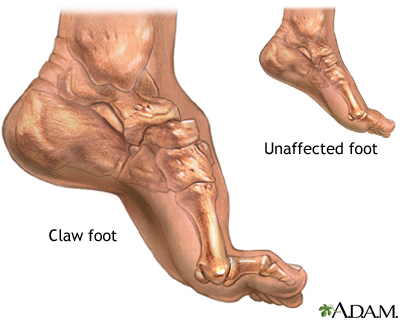Health Library
Claw foot
Claw toes
Claw foot is a deformity of the foot. The joint of the toe that is closest to the ankle is bent upward, and the other joints are bent downward. The toe looks like a claw.
Images

I Would Like to Learn About:
Considerations
Claw toes may be present at birth (congenital). The condition can also develop later in life because of other disorders (acquired). Claw toes may be caused by a nerve problem in the legs or a spinal cord problem or signs of arthritis. The cause is unknown in many cases.
Most of the time, claw toes are not harmful by themselves. Rarely, they may be the first sign of a more serious disease of the nervous system.
Claw toes may cause pain and lead to calluses on the top of the toe over the first joint, but may also be painless. The condition may create problems fitting into shoes.
Causes
Causes may include:
- Ankle fractures or surgery
- Cerebral palsy
- Charcot-Marie-Tooth disease
- Other brain and nervous system disorders
- Rheumatoid arthritis
When to Contact a Medical Professional
Contact your health care provider if you think you may be getting claw toes.
What to Expect at Your Office Visit
The provider will do an exam to check for muscle, nerve, and spine problems. The physical exam will most likely include extra attention to the feet and hands. The provider will examine the flexibility of your toes and ankle.
You will be asked questions about your condition, such as:
- When did you first notice this?
- Did you have a previous injury?
- Is it getting worse?
- Does it affect both feet?
- Do you have other symptoms at the same time?
- Do you have any abnormal feelings or loss of feeling in your toes or feet?
- Do any other family members have the same condition?
The abnormal shape of the toe can increase pressure and cause calluses or ulcers on your toes. Fabric pads or sleeves that cover the top of your toes may help. You may need to wear special shoes to ease pressure. Claw toes can also be treated surgically.
Related Information
Contracture deformityClaw hand
References
Grear BJ. Neurogenic disorders. In: Azar FM, Beaty JH, eds. Campbell's Operative Orthopaedics. 14th ed. Philadelphia, PA: Elsevier; 2021:chap 87.
Murphy GA. Lesser toe abnormalities. In: Azar FM, Beaty JH, eds. Campbell's Operative Orthopaedics. 14th ed. Philadelphia, PA: Elsevier; 2021:chap 84.
BACK TO TOPReview Date: 4/24/2023
Reviewed By: C. Benjamin Ma, MD, Professor, Chief, Sports Medicine and Shoulder Service, UCSF Department of Orthopaedic Surgery, San Francisco, CA. Also reviewed by David C. Dugdale, MD, Medical Director, Brenda Conaway, Editorial Director, and the A.D.A.M. Editorial team.
 | A.D.A.M., Inc. is accredited by URAC, for Health Content Provider (www.urac.org). URAC's accreditation program is an independent audit to verify that A.D.A.M. follows rigorous standards of quality and accountability. A.D.A.M. is among the first to achieve this important distinction for online health information and services. Learn more about A.D.A.M.'s editorial policy, editorial process and privacy policy. A.D.A.M. is also a founding member of Hi-Ethics. This site complies with the HONcode standard for trustworthy health information: verify here. |
The information provided herein should not be used during any medical emergency or for the diagnosis or treatment of any medical condition. A licensed medical professional should be consulted for diagnosis and treatment of any and all medical conditions. Links to other sites are provided for information only -- they do not constitute endorsements of those other sites. No warranty of any kind, either expressed or implied, is made as to the accuracy, reliability, timeliness, or correctness of any translations made by a third-party service of the information provided herein into any other language. © 1997- 2024 A.D.A.M., a business unit of Ebix, Inc. Any duplication or distribution of the information contained herein is strictly prohibited.
